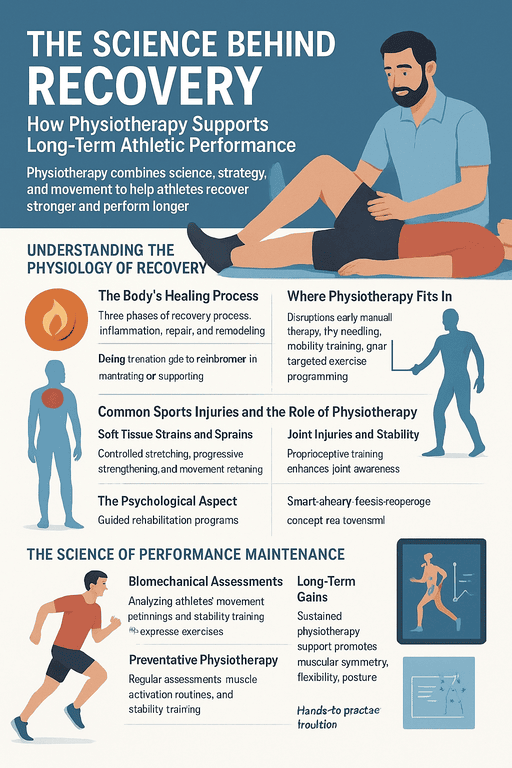Athletic performance isn’t just defined by how hard someone trains — it’s equally shaped by how effectively they recover. Whether it’s a professional footballer, a dedicated runner, or a weekend basketball player, recovery determines how the body adapts, rebuilds, and returns stronger after physical stress. That’s where physiotherapy plays an indispensable role.
Modern physiotherapy has evolved far beyond simple rehabilitation. It’s now a data-driven, evidence-based practice that supports strength, endurance, and mobility while preventing future injuries. For many athletes and active individuals, it’s not a last resort after injury — it’s an ongoing partnership in performance maintenance.
For those aiming to stay active while minimizing downtime, Explore physiotherapy with Next Wave Therapy, a Fremantle-based clinic dedicated to sports recovery, performance enhancement, and movement science.
Understanding the Physiology of Recovery
The Body’s Healing Process
When muscles or joints are stressed, the body initiates a three-phase recovery process: inflammation, repair, and remodeling. Inflammation allows healing cells to reach the damaged area, the repair phase begins rebuilding tissue, and remodeling strengthens the repaired fibres. However, when rest, nutrition, or movement patterns are inadequate, this natural cycle may become disrupted — leading to chronic pain or recurring injuries.
Where Physiotherapy Fits In
Physiotherapy identifies these disruptions early. Through manual therapy, dry needling, mobility training, and targeted exercise programming, physiotherapists work to restore optimal movement and alignment. The approach goes beyond pain relief — it retrains muscles, joints, and the nervous system to function cohesively.
Readers interested in the clinical side of physical care may enjoy Smart-Article’s post on Evidence-Based Health Practices, which examines how science-backed methods are transforming modern recovery treatments.
Common Sports Injuries and the Role of Physiotherapy
Soft Tissue Strains and Sprains
Muscle strains and ligament sprains are among the most frequent sports injuries. They’re often caused by fatigue, poor warm-up routines, or sudden changes in direction. Physiotherapy addresses these issues through controlled stretching, progressive strengthening, and movement retraining. These not only accelerate healing but reduce the likelihood of re-injury.
Joint Injuries and Stability
In sports involving rapid pivoting or impact — such as football or tennis — the joints endure significant strain. Physiotherapists focus on proprioceptive training, which enhances joint awareness and stability. This type of work is especially crucial for knees, shoulders, and ankles, helping athletes regain confidence after recovery.
The Psychological Aspect
Injuries don’t just affect the body; they can challenge an athlete’s mindset. A guided rehabilitation program builds not only physical strength but mental resilience. Working closely with a physiotherapist provides structure and reassurance, two key elements in overcoming fear of re-injury.
For a deeper look at this connection, readers can refer to Smart-Article’s feature on The Psychology of Physical Recovery, which explores the mental challenges behind healing and return-to-sport readiness.
The Science of Performance Maintenance
Biomechanical Assessments
One of the key contributions of physiotherapy to athletic success lies in biomechanical evaluation. By analyzing how an athlete moves, physiotherapists may pinpoint inefficient patterns that waste energy or increase injury risk. Adjusting these through personalized corrective exercises optimizes performance while conserving physical resources.
Preventative Physiotherapy
Preventative physiotherapy, often called “pre habilitation,” involves regular assessments, muscle activation routines, and stability training. The goal is to prepare the body for stress before injury occurs. This forward-thinking approach reduces injury rates, particularly among athletes in seasonal or high-impact sports.
Long-Term Gains
Sustained physiotherapy support promotes muscular symmetry, flexibility, and posture — essential for efficiency in movement. Over time, athletes who incorporate physiotherapy into their training often report fewer setbacks, faster recovery times, and improved overall mobility.
As consistency underpins progress, readers may find Smart-Article’s related post on Consistency and Athletic Growth a valuable companion piece, focusing on how regular habits form the foundation of performance improvement.
Physiotherapy in the Era of Technology
Today’s physiotherapy clinics are adopting digital innovations to refine assessment and treatment. Motion capture technology, wearable sensors, and AI-based tracking software now allow practitioners to monitor biomechanics and rehabilitation progress with precision.
At clinics such as Next Wave Therapy in Fremantle, data-driven physiotherapy programs combine hands-on expertise with digital feedback, ensuring each session adapts to the athlete’s recovery phase and physical needs. This integration of science and technology enhances both accuracy and accountability — making it easier for athletes to stay on track.
Why Every Athlete Needs a Physiotherapy Partner
Physiotherapy isn’t just about fixing what’s broken — it’s about optimizing how the body functions. For athletes, it offers a proactive foundation of injury prevention, movement mastery, and recovery enhancement. Even for those who don’t compete professionally, adopting physiotherapy as a part of their wellness routine promotes mobility and longevity.
Whether it’s for better performance, improved balance, or simply pain-free movement, professional support makes all the difference. To discover what expert-guided recovery may look like, Explore physiotherapy with Next Wave Therapy.
Conclusion: Recovery Is the Real Performance Edge
In the world of sport, pushing limits is celebrated — but smart recovery is what sustains progress. Physiotherapy bridges the gap between healing and performance, helping athletes move efficiently, think confidently, and perform consistently.
As research continues to reveal the body’s incredible adaptability, one thing remains certain: physiotherapy is no longer an optional afterthought. It’s the science that keeps movement alive.
To continue exploring health and performance strategies, readers can check Smart-Article’s post on The Art of Recovery, which examines the importance of balancing rest and activity.


